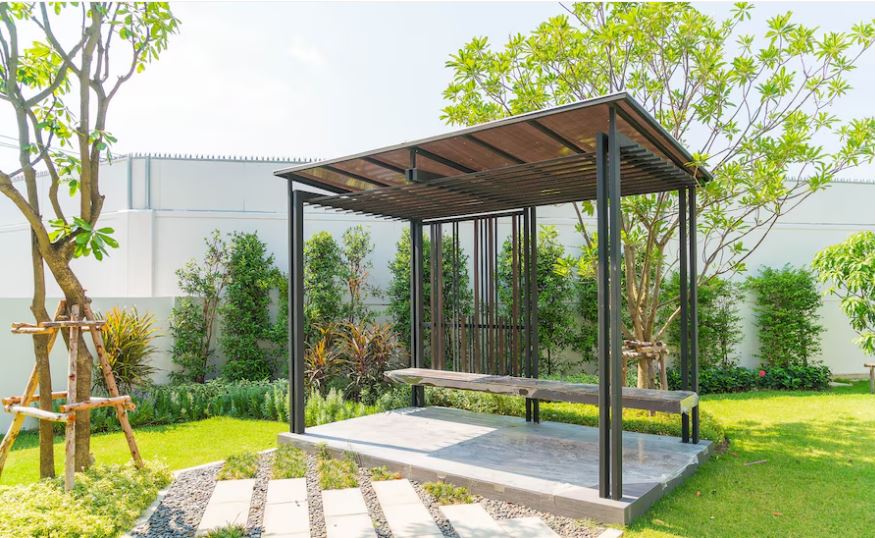Because of their great versatility and affordability, concrete patios have become a fundamental component of contemporary backyard design. Homeowners are transforming these slabs into eye-catching outdoor extensions of their interiors by personalizing the overlays, shapes, and finishes. A carefully designed patio reflects the character and values of the people who use it, much like a well-curated art gallery turns blank walls into narrative-driven expressions. Comfort and beauty are becoming less important than longevity, lifestyle, and harmonious coexistence with the environment.
Architects and do-it-yourselfers alike are gravitating toward organic textures, multipurpose features, and high-efficiency layouts in cities ranging from Seattle to Savannah. Pergolas adorned with wisteria, gravel walkways that double as French-style garden paths, and outdoor kitchen islands wrapped in reclaimed wood have replaced the days when a plastic table and metal chairs were adequate. These areas are purposefully designed to enhance everyday life by facilitating communication, rest, and expression; they are not merely aesthetic enhancements. Backyards are now essential sanctuaries rather than optional luxuries, much like digital tools have gone from being optional to necessary.
Backyard Patio Design Trends and Features
| Feature Category | Description |
|---|---|
| Core Materials | Concrete, Brick, Gravel, Flagstone, Granite, Porcelain, Travertine |
| Trending Styles | Cottage Garden, Modern Minimalist, English Courtyard, Mediterranean |
| Key Functional Features | Fire Pits, Outdoor Kitchens, Pizza Ovens, Waterfalls, Retractable Canopies |
| Popular Furnishings | Sectionals, Adirondack Chairs, Modular Seating, Dining Tables with Umbrellas |
| Lighting Enhancements | Edison Bulbs, Solar Pathway Lights, Copper Lanterns, Motion Sensors |
| Climate-Specific Tips | Porcelain for flooding zones, Concrete for freeze-prone areas, Slate for dry climates |
| Celebrity Inspiration | Jennifer Aniston’s eco-retreat, Martha Stewart’s garden kitchens, Ellen DeGeneres’ minimalist vibe |
| Sustainability Features | Permeable Pavers, Native Plants, Solar Panels, Rainwater Catchment |
| Budget-Friendly Options | Painted Concrete Rugs, DIY Fire Bowls, Gravel Walkways, Repurposed Brick |
Designers are creating environmentally conscious and emotionally calming spaces by combining textures like crushed granite and decomposed stone with soft greenery. It’s no accident that this trend mirrors more general movements toward biophilic design, which incorporates nature into constructed spaces to lower stress and improve cognitive function. Homeowners, particularly those who are juggling work and family responsibilities, are investing in their patios as places for relaxation and productivity as well as entertainment. After a day spent surrounded by electronics, these outdoor lounges have evolved into peaceful havens where people can unwind.
The patio has become a status symbol of subtle luxury in the homes of celebrities. Take Reese Witherspoon’s veranda, which combines handmade ceramic tiles, vintage planters, and wrought iron fixtures to create a Southern-inspired look. Or Oprah’s retreat on Maui, where a sequence of interconnected terraces with views of the Pacific Ocean are embraced by native foliage. These outdoor areas convey very intimate tales and frequently represent the heritage, ideals, and design philosophies of their owners. A growing emphasis on personalization—curating items with sentimental value or regional flair—occurs as more homeowners follow suit.

Flagstone has become a particularly creative material option, particularly when placed between moss or grass. It is perfect for homes that aim to blur the line between hardscape and landscape because it combines structural integrity with a laid-back, organic aesthetic. The eye and foot are naturally guided through seating nooks, garden beds, and water features by flagstone paths, which are remarkably effective at grounding visual compositions. Designers have even used it in conjunction with LED underlighting in some projects, transforming a path during the day into a focal point at night.
Once only functional, lighting now contributes to the patio story in a transformative way. Designers create visual poetry after sunset by carefully layering elements such as low-voltage string lights woven into fences, lanterns suspended from pergola beams, and uplights beneath planters. According to homeowners, these lighting designs have significantly increased their capacity to use the area after hours. The atmosphere produced is similar to that of a boutique resort: cozy, welcoming, and naturally soothing. “The right lighting turns a simple concrete pad into a stage set for memories,” according to a landscape architect from Austin.
The choice of furniture has also been conceptually improved. Integrated design packages that emphasize symmetry, ergonomic comfort, and weather resistance are becoming more popular than standalone purchases. Retail lines are dominated by stackable bistro sets with UV-resistant cushions, teak lounges made from sustainable sources, and modular sofas with concealed storage. These are not only aesthetically pleasing; they are also incredibly effective ways for families to balance practical requirements with artistic aspirations. Additionally, even lightweight frames now perform remarkably well throughout the seasons because of developments in materials science.
Zoning is important when it comes to layout. Similar to interior rooms, professionals are dividing patios into distinct areas for cooking, dining, conversing, and even peaceful contemplation. Movement is gently guided while maintaining openness through the use of visual dividers such as trellises, vertical gardens, or alternating paver textures. This type of outdoor compartmentalization proved crucial during the pandemic, and its benefits have outlasted social distancing tactics. For many, it’s a framework that encourages celebration and solitude—on one’s own terms.
The ornamental component has also grown up. Today’s patios frequently feature commissioned artwork that is resistant to weather damage, sculptural fire pits, and custom mosaics, which are no longer limited to plastic planters or wind chimes. In order to create unique tile work or mural walls that reflect family histories or significant life events, artists are even working with homeowners. Even though these details are small, they have a big emotional impact and turn functional patios into incredibly meaningful additions to the house.
Gravel continues to be a surprisingly stylish and reasonably priced option for renovators on a tight budget. Gravel surfaces are particularly useful in areas with erratic weather patterns or inadequate drainage infrastructure because they are simple to install and maintain. Gravel offers secure, heat-absorbing footing around a fire pit. The result is a rustic elegance that rivals more expensive options when combined with striking planters and woven seating. This trend has been embraced by influencers on websites like YouTube and Pinterest, who provide tutorials that combine high design impact with usefulness.
Smart technology, such as motion sensors, Bluetooth speakers, and automated awnings, is being incorporated into patio designs to push the limits of innovation and leisure. Due to these features’ noticeably enhanced functionality and surprisingly low installation costs, homeowners are embracing them more and more. Essentially, the contemporary patio is starting to represent both individual identity and the development of society. It is the intersection of innovation and tradition, form and function, and nature and nurture.
